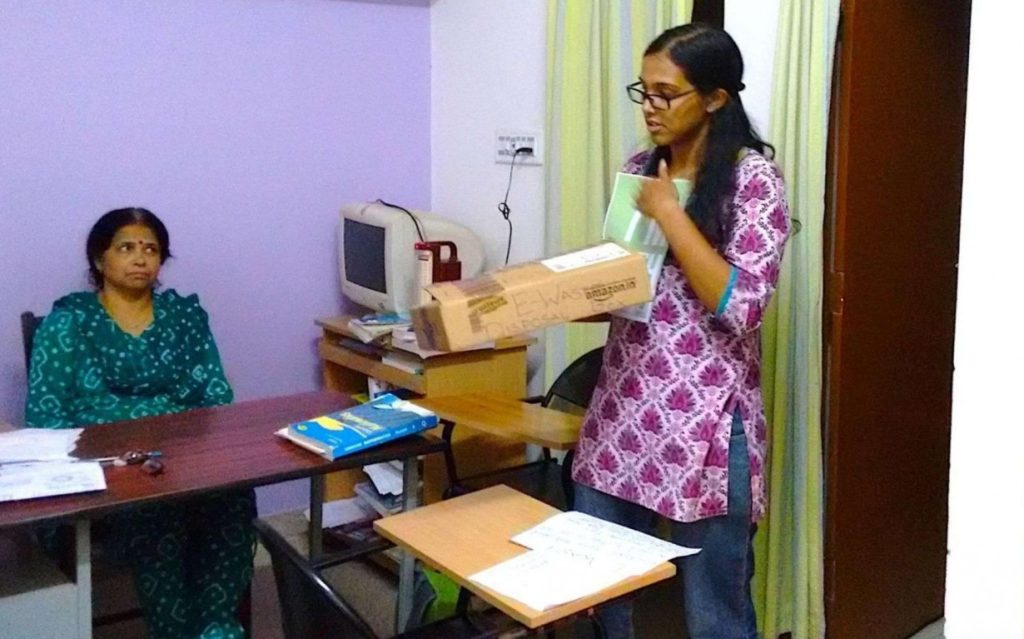
E-Waste Awareness For Future Changemakers At Bangalore, India
Global E-waste Monitor Report 2014 estimates the total amount e-waste generated in 2014 accounting to 41.8 million metric tonnes!
A child is not a vase to be filled, but a fire to be lit.FRANCOIS RABELAIS
To ignite a spark about E-waste and it’s management, an awareness drive among future changemakers and the children of today, was conducted by Smriti Tiwari(Earth5R Bangalore) at Smart Tutorials, Kodichikanahalli, Bangalore. It was conducted at 6 pm on 14th October, 2015. The audience were a group of 15 children from class 6 to class 12.
“E-waste is a term used to cover all items of electrical and electronic equipment (EEE) and its parts that have been discarded by its owner as waste without the intent of reuse” (Step Initiative 2014). E-waste, or waste electrical and electronic equipment (WEEE), is a complex and fast-growing waste stream that covers a large variety of products. The composition of this waste stream, that is, its constituents including toxics and its resource potential, varies significantly by product. This make e-waste management a difficult task.
According to the Global E-waste Monitor Report 2014, it is estimated that the total amount e-waste generated in 2014 was 41.8 million metric tonnes (Mt). It is forecasted to increase to 50 Mt of e-waste in 2018. This e-waste is comprised of 1.0 Mt of lamps, 6.3 Mt of screens, 3.0 Mt of small IT (such as mobile phones, pocket calculators, personal computers, printers, etc.), 12.8 Mt of small equipment (such as vacuum cleaners, microwaves, toasters, electric shavers, video cameras, etc.), 11.8 Mt of large equipment (such as washing machines, clothes dryers, dishwashers, electric stoves, photo voltaic panels, etc.) and 7.0 Mt of cooling and freezing equipment (temperature exchange equipment).
This talk began with the simple question of how many electronic devices the students had at home. Most gave numbers above 10, including phones, tablets, laptops, pen drives etc. Then, they were asked what they did when these things stopped working. The obvious answer was that they try getting them fixed and if the devices still don’t work, they are directed to the dustbin. This is where the critical questions came in the picture- which dustbin and what happens to the e-waste after that?
Pooja, a class 10 student, immediately replied that in her layout they have a separate e-waste bin but she didn’t know what they did with it. The other students agreed to just putting them with the dry waste at home or at most selling into the local “kabadiwalla”.
They were then informed about the harms of dumping e-waste with the dry waste. Students were told about how metals can leach into soil and contaminate ground water and effect soil fertility if they are dumped in landfills, while burning e-waste in incinerators causes increase in the suspended particulate matter in the air. The latter leads to respiratory and cardiovascular diseases. The children were surprised to learn about the impacts and immediately questioned about what could be done to stop it. This question was answered by telling them about various institutions around Bangalore that collect this e-waste and dispose it off correctly. They took down details of the closest center and vowed to inform their parents, friends, relatives and neighbours about this.
Going a step further, tuning words into action, an e-waste collection box was installed at the tuition center and the first item also was put into it. It was a discharged battery from a clock. This completed the cycle of Know-Inspire-Act.
The main idea behind doing this talk was to engage an audience of various ages and schools, creating an amplified impact. In a hope, they will become the propellers of the Winds of Change and help us create a better tomorrow.
The Earth5R team thoroughly enjoyed this interaction with these children and hopes to continue working with them to make a difference.
–Written by Smriti Tiwari. Edited by Pragya Lodha




